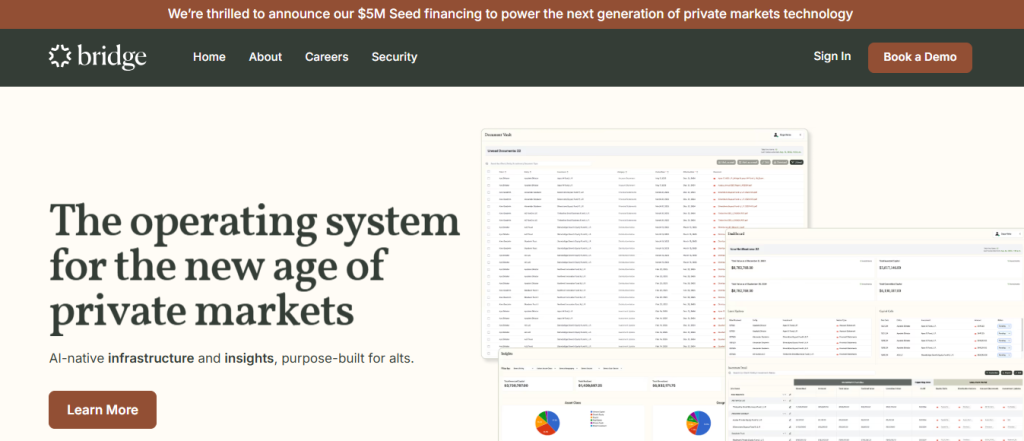Bridge Raises $5.1 Million Seed Round to Build the Unified Operating Layer for Wealth Management Firms
November 4, 2025
byFenoms Start-Ups

Bridge has raised $5,100,000 in their Seed round, led by Thicket Ventures with participation from Bill Lewis, Tricia Bain, Nate Sleeper, Dani Fava, Ed Swenson, Molly Bennard, Peter Lee, Chris Piazza, David Hauser, and others. Founded by Alex Goodwin, Bridge is solving a critical - and long-ignored - problem inside wealth management: client financial data is fragmented across custodians, trading systems, banking relationships, advisory platforms, and manual spreadsheets. Wealth management firms have more tools than ever, but no unified operating layer that ties those systems together into one coherent view. Bridge integrates custodial data, client assets, historical records, workflows, firm operations, and CRM functions into one platform so advisors can actually run their firm - not chase data around. Bridge isn’t just improving visibility. It’s giving wealth management firms their first real operating system.
Reframing WealthTech: Not “Track Client Assets” - but “Operate the Firm in One Place”
For decades, wealth management software has been built around singular functions: one system for client reporting, one for CRM, one for financial planning, one for custodial data, one for operations. Advisors have become system-switchers instead of strategic operators. The result? Context gets lost, work gets duplicated, and firms rely on spreadsheet glue to hold everything together. Bridge flips that paradigm by centralizing the entire operational backbone of a firm into a single, live source of truth. Instead of moving between eight different platforms, advisors see one clean view. Instead of gathering data, they use data. Bridge is replacing “information management” with “firm management.”
Infrastructure Over Software: Bridge Becomes the Command Center of the Modern Advisory Firm
Bridge is not another fintech tool trying to wedge itself into the tech stack. Bridge is the stack. It sits beneath the firm’s systems and unifies data across custodians, accounts, assets, client directives, workflows, and internal operations. Everything that matters operationally - onboarding, document requests, approvals, compliance, scheduling, communications, task automation - flows through Bridge. Instead of advisors bending their workflows to their tools, Bridge molds technology to the workflows that already exist. The difference between tools and infrastructure is dependency. Tools are helpful. Infrastructure is required.
Don’t Build Software Users Interact With - Build Software They Can’t Operate Without
Here’s the real strategic difference that positions Bridge for category leadership: most products compete for attention, but Bridge competes for dependency. Advisors don’t just log into Bridge; their workflows run through it. Firms stop asking “Should we use this?” and instead face “We can’t function without this.” Startups often obsess over retention strategies and adoption. Bridge skipped that step by positioning itself at the core operational layer - the place where decisions happen, where workflows begin, and where data moves. When your product powers the operation, churn becomes impossible.
Investor Alignment: Strategic Operators Betting on Infrastructure, Not Features
Bridge’s investor roster is stacked with leaders from fintech, custodial platforms, and wealth management operations - people who understand the pain firsthand and know exactly how expensive inefficiency is. These investors aren’t betting on another advisory dashboard. They’re backing the software that advisory firms will run on. Advisory firms are increasingly choosing platforms that reduce operational complexity and expand their ability to serve more clients at higher margins. Investors see a simple truth: the future of advisory growth won’t be driven by hiring more staff. It will be driven by automating operational drag.
A Market That’s Growing but Operationally Broken
Wealth management is booming - but the back-office work is suffocating that growth. Advisors are drowning in administrative overload and data fragmentation. The numbers are clear:
- Wealth management firms report spending up to 40% of weekly hours on admin tasks, not advising.
- Advisors are expected to manage 3x more clients than a decade ago, but software hasn’t evolved to support that scaling.
- The registered investment advisor (RIA) segment is expected to reach $130 trillion in AUM by 2030, yet operational inefficiency is the #1 barrier to firm growth.
The industry doesn’t have a client-acquisition problem.
It has a complexity problem.
Advisors don’t lack platforms.
They lack unification.
Why Bridge Wins: Automation Turns Growth Into Scale
Advisory firms grow until their operations break. Then they hire headcount to compensate. Bridge introduces a model where operational intelligence replaces operational labor. The platform automates manual workflows, eliminates redundant data entry, ensures accuracy of custodial and account data, and reduces follow-ups and status tracking. Advisors stop chasing information and start acting on insights. When fragmented data becomes structured intelligence, an advisory firm becomes scalable - without adding bodies. Growth becomes a multiplier, not a burden.
What’s Next for Bridge
With $5.1M in new capital, Bridge is expanding its engineering team, deepening integrations with major custodians, and building multi-entity visibility so firms can operate multiple advisors, teams, and offices from one unified dashboard. The company is enhancing real-time data feeds and building automations that trigger actions based on defined business rules. The long-term vision is unambiguous: Bridge becomes the enterprise nerve center of the wealth management industry - the single platform where operations live and scale. Firms will run onboarding, client management, compliance, communications, reporting, and account administration all in one place. Bridge isn’t improving how advisors work. It’s removing the need to operationalize work in the first place.
Final Thoughts
The wealth management industry is at a tipping point. For decades, firms solved problems by adding more tools, more complexity, and more staff. But the firms that will lead the next decade won’t be the ones that operate harder. They’ll be the ones that operate cleaner. Bridge represents the shift from fragmented operations to centralized command - from software that documents the work to software that drives it. Most fintech tools give advisors data. Bridge gives advisors leverage. The future of firm growth is operational intelligence - and Bridge is building the operating system that delivers it









